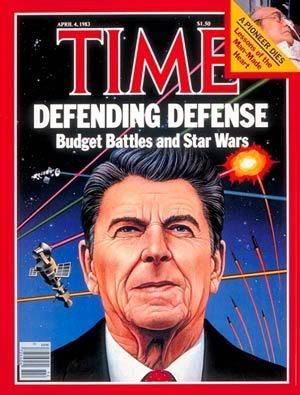Twenty-five years ago tomorrow, before a television audience, President Ronald Reagan initiated one of the grandest defense boondoggles of all time, the Strategic Defense Initiative. Like many boondoggles, it was couched in sweet talk and lies:

The defense policy of the United States is based on a simple premise: The United States does not start fights. We will never be an aggressor. We maintain our strength in order to deter and defend against aggression — to preserve freedom and peace. …
What if free people could live secure in the knowledge that their security did not rest upon the threat of instant U.S. retaliation to deter a Soviet attack, that we could intercept and destroy strategic ballistic missiles before they reached our own soil or that of our allies?
I know this is a formidable, technical task, one that may not be accomplished before the end of the century. Yet, current technology has attained a level of sophistication where it’s reasonable for us to begin this effort. It will take years, probably decades of efforts on many fronts. There will be failures and setbacks, just as there will be successes and breakthroughs. And as we proceed, we must remain constant in preserving the nuclear deterrent and maintaining a solid capability for flexible response. But isn’t it worth every investment necessary to free the world from the threat of nuclear war? We know it is.
Those lines and the rest of the speech sure sounded good to many. As had been the case almost since the arrival of Werner von Braun and the other V-2 rocket engineers at the end of World War II, when it came to space, America talked peace and prepared for war. After sputnik went beeping around the planet every 96 minutes in 1957, the effort was greatly intensified, always with the threat of Soviet attack as the rationale. This was true whether it was JFK campaigning about a bogus “missile gap” or a 1980s Pentagon inflating Moscow’s military power at the urging of the Committee on the Present Danger’s nascent neo-conservatives. Reagan’s speech was nothing new on that score.
In fact, U.S. talk about putting weapons onto the ultimate high ground of outer space started well before President Reagan gave his Star Wars speech. In 1947, German Major General Walter Dornberger, who had headed the Nazi rocket program, began officially advising the U.S. Air Force. Like any good Nazi, he recommended putting nuclear bombs into orbit to attack Soviet cities and military installations. He also proposed a space-based defense against missiles, an orbiting ring of hundreds of satellites, sentries armed with small rockets capable of destroying enemy ICBMs.

